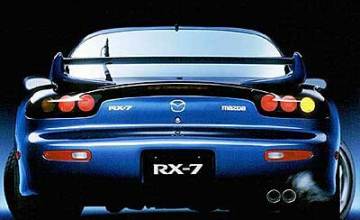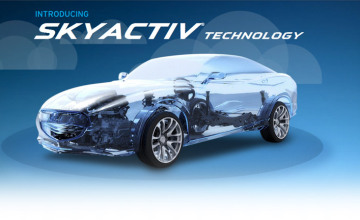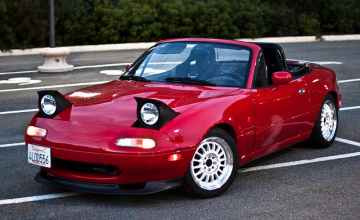Hatchbacks enjoy a unique position in the marketplace. Along with their easily accessible cargo area, they also deliver the feel of a sedan and better fuel efficiency than compact SUVs. All that, and they’re affordable, too.
The Mazda 3 has been one of our favorite hatchbacks for some time, and the latest redesign has only made it that much better. That dominance is now being challenged with the introduction of the all-new 2015 Volkswagen Golf. To find out if the VW has what it takes to unseat the Mazda, we put both through our rigorous testing and evaluation regimen. We had a feeling this was going to be a close race, and we were right.
An All-New Golf That’s Bigger and Better
From the outside, the 2015 Volkswagen Golf is a subtle evolution of its predecessor. The updated styling gives it a slightly more chiseled and slimmer look than before, even if the dimensions have grown slightly. It gains 2 inches in overall length (primarily between the front and rear wheels) and half an inch of width. It is shorter by an inch in height, though. Still, it’s unmistakably a Golf.
2015 Volkswagen Golf
More significant changes happen underneath the new sheet metal, as this Golf now shares its basic platform with the Audi A3. Under the hood is a 1.8-liter turbocharged four-cylinder engine that produces 170 horsepower and 200 pound-feet of torque. This replaces the outgoing naturally aspirated 2.5-liter engine that made 170 hp and 177 lb-ft.
Prices start at $18,815 for the two-door Launch Edition Golf and $20,915 for the four-door Golf S base model with a five-speed manual transmission ($22,915 for the six-speed automatic). Our Golf test vehicle in range-topping SEL trim is only available as a four-door with the automatic and starts at $27,815.
For the added cost, you get 18-inch alloy wheels, a sunroof, automatic wipers and headlights, foglights, a navigation system, dual-zone automatic climate control, a rearview camera, keyless ignition and entry, heated front seats (12-way power-adjustable for the driver), faux leather upholstery, ambient interior lighting and a premium audio system. On top of that is the optional Lighting package for $995 that adds bi-xenon headlights, LED running lights and cornering lights. The final tally comes to $28,810.
An Entirely Different Mazda 3
The 2014 Mazda 3 changes are far more significant compared to its previous generation. Styling is sharper inside and out, while interior quality improvements and new features make its predecessor barely recognizable by comparison. Like the VW, the new Mazda 3 rides on a longer wheelbase and is wider overall. Overall length is down by almost 2 inches, however, and height drops by about half an inch.
2014 Mazda 3
Our 2014 Mazda 3s test vehicle is powered by a 2.5-liter four-cylinder engine that makes 184 hp and 185 lb-ft of torque. This represents an upgrade from the Mazda 3 i base model’s 2.0-liter engine that produces 155 hp and 150 lb-ft. The new 2.5-liter engine improves upon the previous year’s output of 167 hp and 168 lb-ft, while the base 2.0-liter gains only 2 lb-ft of torque. A traditional six-speed automatic is the only transmission available with the larger engine. A six-speed manual is standard on the base engine.
Prices for the Mazda 3 i hatchback in Sport trim start at $18,945. In the top-of-the-line Grand Touring trim like our test vehicle, the price of admission climbs to $27,290. For that money, you get everything the VW Golf has, minus the ambient lighting and driver seat adjustments for cushion angle. You do, however, get adaptive headlights, rear cross-traffic alerts, an auto-dimming rearview mirror, genuine leather upholstery, a driver head-up display, HD radio and streaming Internet radio. With the optional cargo mat, rear bumper guard and door sill scuff plates, our Mazda 3 test vehicle costs $27,585.
How Do They Drive?
Under normal commuting conditions, the 2014 Mazda 3 and 2015 Volkswagen Golf both deliver a comfortable ride, even though their suspensions are a bit stiffer than the Ford Focus or Kia Forte. The Mazda and VW end up feeling a little more solidly planted to the road as a result.
Both hatchbacks also get up to speed with confidence, and you’d be hard-pressed to determine if one is quicker than the other. In Edmunds testing, it was a close race, with the Mazda 3 reaching 60 mph in 7.5 seconds, barely edging out the Golf’s 7.8-second run. There’s a greater difference, however, in the manner in which these two cars gather speed.
2014 Mazda 3 vs. 2015 Volkswagen Golf
The Mazda 3’s conventional automatic transmission helps it leave the line smoothly with an even application of power. Shifts are quick and smooth enough that you rarely even take notice. The Golf, on the other hand, requires either a very light pedal application to slowly accelerate or an aggressive boot stomp to give it a hard launch. Moderate pedal pressure tends to result in uneven power delivery. Initially, there’s very little movement, followed by a slight lurch forward, followed by a more noticeable lurch before it settles into smooth acceleration.
There are also a few unrefined stumbles during deceleration in the Golf. When coasting to a stop, an occasional shift into a lower gear produces a subtle lurch. The Mazda 3 has no such issues. When you need to really get slowed down, both cars do so with strong results. In panic braking tests from 60 mph, the Golf stopped in a respectable 119 feet with some notable nosedive and a softening pedal after repeated runs. The Mazda 3 stopped in 121 feet with little nosedive and a consistently firm pedal, but there was some slight squirming noted by our test driver.
When it comes to fun behind the wheel, the gap between these cars widens. The Mazda 3 is the clear winner in this regard, as it rewards a spirited driver with sharp, communicative steering that places you precisely where you intend. It corners flatly though sharp bends, instilling high levels of confidence and entertainment. The Volkswagen is no slouch either, but it does not match the Mazda’s performance. The Golf’s steering effort is lighter than the Mazda’s and it remains light at speed, too. This translates to a little less driver feedback and confidence. Compounding matters is an abundance of body roll while cornering.
In our handling tests, the Mazda 3 returned results that were marginally better than the Golf, but the seat-of-the-pants feel is undeniably in the Mazda’s favor. The good news is, if you really want a stronger-performing Golf, there’s always the performance-oriented GTI model. A performance-oriented Mazda 3 has yet to be officially announced.
How Is It Living With These Hatchbacks?
Both the Mazda 3 and Volkswagen Golf have interior designs that will likely exceed expectations for anyone shopping in this class. The Golf showcases its distinctly German heritage with an austere look and quality materials. Controls, gauges and the 5.8-inch touchscreen are well placed, clearly labeled and easy to operate. Front seats are covered in VW’s V-Tex leatherette and have the look and feel of the real stuff, though after a few hours they can get a little stifling. They’re also roomy and supportive for taller and shorter drivers alike.
2015 Volkswagen Golf
Rear seats have just enough headroom for the average 5-foot-10 adult, but the low-mounted seat cushion makes them more suitable for smaller passengers. Behind those seats is a space that can hold up to 22.8 cubic feet of cargo. It’s important to note, though, that this is measured if you stack your items all the way to the roof, thus impeding visibility. Fold the seats flat and the capacity increases to 52.7 cubic feet.
Step into the Mazda 3 and you’re greeted by a more contemporary design with organic shapes. Mounted atop the dash is an iPad-like 7-inch touchscreen display with a controller dial right where your inboard hand would rest on the center console, much the same way Mercedes and BMW do nowadays. This layout allows the driver to operate the system without having to look away from the road. It’s easy to use and performs flawlessly.
2014 Mazda 3
When it comes to the Mazda’s cargo capacity, figures can be a little misleading. Like the Golf, the Mazda 3’s cargo hold is measured to the roof, and the raked-back rear window cuts into that volume. With the rear seats in place up to 20.2 cubic feet of cargo can fit in back, but in regard to real-world usability (where most do not stack stuff all the way to the top), there’s noticeably more space available than in the Golf. Fold the rear seats flat and there’s less space than the VW, but at 47.1 cubic feet, there’s still ample room for bulky items.
Which Hatchback Returns Better Fuel Economy?
On paper, the Mazda 3 and Volkswagen Golf are close to being equals when it comes to fuel economy. The EPA rates the Mazda at 31 mpg combined (27 city/37 highway), while Volkswagen says the Golf will return 26 mpg in the city and 36 mpg on the highway. (Official EPA numbers haven’t been announced yet.)
In practice, however, the Mazda handily beats the VW by exceeding those estimates with a 41.1-mpg average on our highway-heavy evaluation loop and 28.9 mpg over several months. By comparison, the Golf only managed to achieve 32 mpg on our loop and 25.3 in its time with us.
It’s worth noting that a diesel-powered Golf TDI will be available and should at least match the Mazda’s figures. Unlike some other turbocharged vehicles, our Golf test vehicle did not require premium gasoline.
What About Safety?
Both Mazda and Volkswagen hatchbacks come standard with a rearview camera, antilock disc brakes, stability and traction control, front side airbags and side curtain airbags. The Golf is unique for its driver knee airbag and a new standard post-crash braking system that automatically applies the brakes after an impact to reduce the likelihood of a secondary crash. Optionally, shoppers can add features like forward collision warning and front and rear parking sensors.
Mazda pushes safety feature content quite a bit further by including a rear cross-traffic alert system on the Grand Touring trim. Other features like a blind-spot monitoring system, a lane departure warning system and forward collision alert with automatic braking are also available as options.
Government crash tests have yet to be published for the 2015 VW Golf, but the 2014 Mazda 3 received five out of five stars for overall crash protection.
And the Winner Is…
The margin of victory in each category is slim, but the 2014 Mazda 3 emerges as the undeniable overall victor against the 2015 Volkswagen Golf. The VW’s transmission performance stands out as the only noticeable blemish, and it’s admittedly a minor one.
Even ignoring that drawback, the Mazda 3 comes out on top thanks to its lower price, higher feature content, better performance and impressive fuel economy. In the absence of another hatchback challenger on the horizon, it looks as though the Mazda 3 will enjoy its top spot for a while.
About the Author
Cardine Way




